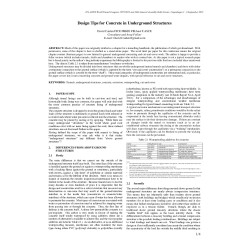Cart
0
0
No document
0,00 €
Total
Document successfully added to your shopping cart
Quantity
Total
There are 0 items in your cart.
There is 1 item in your cart.
Total documents
Total shipping
To be determined
Total
Search & filter
Search for a publication
Search & filter
Viewed documents
Design Tips for Concrete in Underground Structures
Design_Tips_for_Concrete_in_Unde
Much of this paper was originally drafted as a chapter for a tunnelling handbook, the publication of which got abandoned. With permission, some of the chapter is here re-drafted as a stand-alone paper. The word limit per paper for this conference means the original chapter content (fourteen pages) is now limited to general underground concreting and cut-and-cover work. The author is happy to provide a fuller version (which includes tunnels, shafts and chambers) to readers who wish to contact him. As this paper is not a typical research paper but is based purely on the author’s long industry experience the bibliography is limited to his previous talks that have included ideas mentioned here. The data in Table 2.1 is taken from manufacturers’ brochures or websites. Underground structures may be divided into those structures that are wholly underground (mined tunnels and chambers) and those with either a temporary connection to the ground surface (which is captured by the term “cut-and-cover construction”) or a permanent connection to the ground surface (which is covered by the term “shaft”). These main categories of underground construction are summarized and, in particular, the paper covers key issues concerning concrete and ground water impacts, with special reference to cut-and-cover structures.




